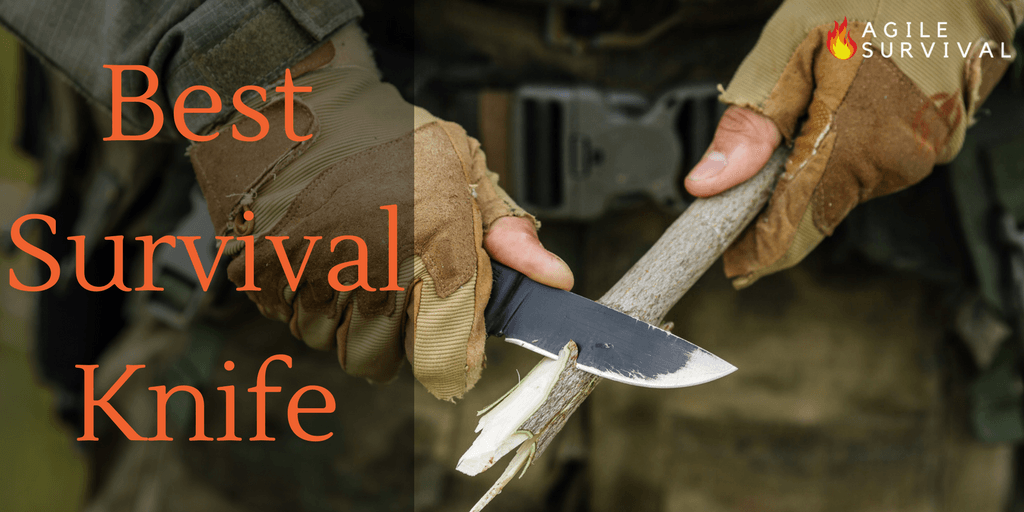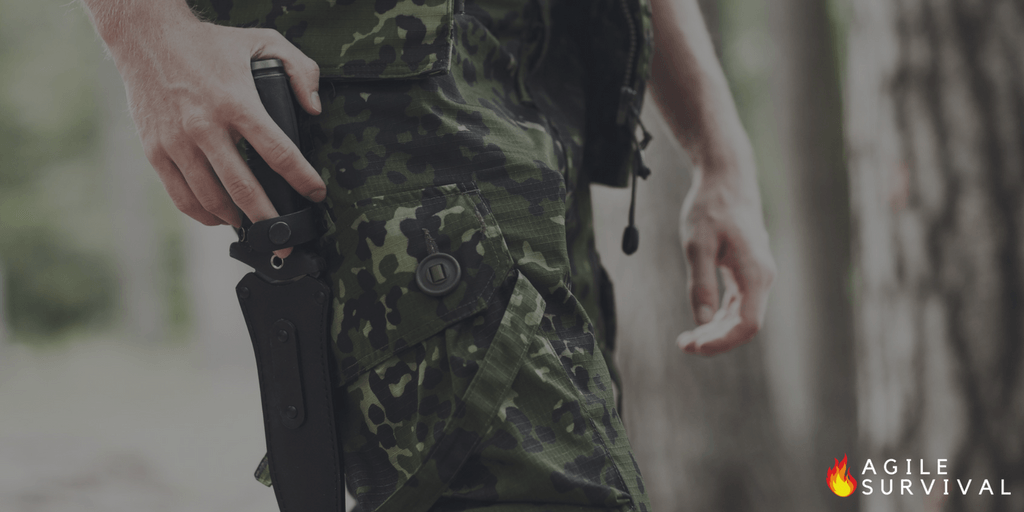
To save you time, the Gerber StrongArm is our pick for the best survival knife for the money.
Nothing compares to the versatility, strength and usefulness a survival knife offers. And, not every knife is designed for survival situations. There are many features that every survival knife must have.
Your search starts here with our comprehensive guide to survival knives. First, we review the most important features to look for. Then walk through 5 of the best survival knives on the market today.
Best Survival Knives for the Money
What to Look for in a Survival Knife
Full Tang
This is one of the most important features of any survival knife or machete. For a full tang knife, the handle is actually the tang itself. In many cases, it covered with some other material for comfort purposes.
A full tang minimizes the chances of the handle breaking off and gives you increased wielding power. It also gives you increased balance because the weight of the metal extends to both ends of the knife.
Reasonable Size
Reasonable size is very relative. What it means is that your survival knife should be large enough to handle heavier tasks but small enough to do intricate work like making traps. Reasonable size varies from one person to another. But, it usually falls between 4-inches to 6-inches for the blade length, and a little over 10 inches for overall length.
Fixed Blade
There are many folding knives that work great in survival situations. However, you will get more out of your knife if it has a fixed blade. A folding knife creates more weak points and hence, reduced longevity as compared to a fixed blade knife.
Straight Edge
Everyone has a different opinion whether a survival knife should have a straight or a serrated edge. I personally believe you should opt for a straight edged survival knife. It's good for carving and batoning. It's also more versatile and easier to sharpen than other any other type of edge.
A serrated knife will do a better job of cutting through thin metal or rope. Some models are partially serrated too. But, in my opinion, they don't have enough serration to be useful.
Bottom line, a knife will a straight edge will be useful far more often. Choose straight over serrated unless you have a specific need for the later.
Blade Material: Type of Steel
Survival knives are usually made from either stainless steel or carbon steel.
Most survivalists prefer high quality carbon steel knives. They are stronger, have high edge retention and are easy to sharpen. Their increased strength makes them better for heavy duty tasks like chopping and cutting wood.
Stainless steel knives are more corrosion resistant. Yet, they aren't as tough. And, they are more difficult to sharpen than carbon steel knives. Stainless steel is a good investment if you are working in a wet environment.
A great option is high carbon steel. But, it is more expensive. High carbon steel knives are a made from a combination of carbon steel and stainless steel. Offering the best of both materials.

Sharp Point
Look for a knife with a pointed tip, preferably a drop point blade. Stay away from anything with a curved tip. It makes stabbing difficult. A sharp, pointed tip capable of stabbing in case you need to defend yourself from wild animals or in a combat situation.
Blade Thickness
Deciding on the appropriate blade thickness is difficult, especially for someone who isn't a knife expert. The best thickness range for survival knives is about 3/16 to 4/16 of an inch.
Flat Ground Spine
The spine refers to non sharp edge or back edge of the knife.
I recommend a flat ground spine over a beveled or round spine. It will serve you better. Flat ground spines are better at starting a fire with a ferro rod as well as batoning. This also means a double edged knife isn't the best for survival purposes.
Handle
The handle material varies widely from one model to another. Some are made from polymer while others are crafted from hard rubber.
Avoid anything that has a hollow handle for additional storage as it doesn't have a full tang. Partial tang won't cut it. A compass in the handle design is also not necessary as it only messes up with the grip.
Sheath
The sheath affects how well you carry and draw your survival knife. The ideal sheath should have a lower attachment, belt and lanyard attachment, as well as a strap.
The lower attachment is usually a hole or piece at the tip end of the sheath. It allows you to attach your knife to a backpack strap or your leg when on the belt.
The strap allows the sheath to close itself around the knife. Avoid sheaths with a strap at the base of the handle. They make it easy for the knife to slide out. Something a crossover strap where the sheath meets the handle is best.
Best Survival Knives of 2019 Reviewed
1. Gerber StrongArm Fixed Blade Knife
Taking the crown for best survival knife is the Gerber StrongArm, a fixed blade knife that looks and feels like a military knife.
Survivalists will appreciate the multi mount sheath and coyote brown handle. It comes with a full tang, 3/16" thick blade crafted from 420HC steel.
The blade is coated with ceramic and has a serrated edge. The weight falls to the tip of the blade and feels very well balanced in your hand.
It has an overall length of 9.8 inches, with the blade being 4.8 inches. This is a good size, especially for wood crafting. The size balances the knife well, both in usability and weight. Plus, the roughly equal proportions between the handle and blade add to the knife's aesthetics. The StrongArm has a half flat grind, and the spine is so well finished that it will do a great job of scraping a ferro rod.
The handle has matching guards on both sides, which gives your thumb a comfortable resting place. Important when making a cut and added protection for the index finger.
There is an exposed point on the pommel that you can use as a glass breaker in case of an emergency.
Pros
Cons
2. Ka-Bar Becker BK2 Companion Fixed Blade Knife
The Ka-Bar Becker BK2 Companion is a solidly built survival knife that has captured the hearts of many rugged survivalists.
It has an overall length of 10 5/8 inches, a 5.25" blade and weighs about 16 ounces. Despite its small size, this knife boasts a chunky design and a 0.25" thick blade forged of 1095 high carbon steel.
It has a classic drop point blade, a sturdy tip and a high flat grind. The knife also has a heavily textured powder coating for longevity and rolling resistance.
It's amazing what you can do with a knife this size. From splitting wood to carving stakes, you can use the Ka-Bar Becker BK2 Companion for both heavy-duty and light-duty tasks. It is also a decent chopper and will come handy for chores around the camp site.
This knife features a zytel handle and a full tang. Zytel is a high density plastic that lasts a long time. Because the hardware is sunk deep into the handle, you don't have to worry about sharp edges. There is a pommel that you can use for hammering as well as a lanyard hole.
Pros
Cons
3. Gerber Bear Grylls Ultimate Knife
The Gerber Bear Grylls Ultimate Knife was designed by outdoor expert Bear Grylls. It bears distinctive black, grey and orange styling.
The knife comes with a fixed blade crafted from 7Cr17Mov stainless steel.
The blade is partially serrated and has a ¾ tang, a disappointment compared to full tang knives. A version of this knife without serrations is also available.
The Bear Grylls Ultimate Knife has a rubberized knife. And, to add to its survival nature, there is a foldable guide that tucks into the nylon sheath.
Also included is a whistle, which is a part of the lanyard, and a textured metal end cap that you can use for hammering. I love how the blade locks into the plastic sleeve that's a part of the sheath. This ensures that the knife doesn't slide out of the sheath.
Pros
Cons
4. Ontario 499 Air Force Survival Knife
The Ontario 499 Air Force Survival Knife is a military grade knife designed as part of the USAF Survival Kits.
Its 5 inch blade is made from 1095 stainless steel with spine serrations and full tang. The blade is coated with phosphate for improved corrosion resistance.
Ontario's knife has a strong steel pommel for hammering, as well as durable leather sheath. You will be happy to know that the sheath is grommeted for strapping and lashing.
Like the previous model, this model has great edge retention and is quite versatile. From cutting through a plane's aluminum fuselage to cutting bushes to clear the path ahead, this knife can handle almost anything you throw at it.
The grip is comfortable and solid since the handle is made from natural leather. In addition to a good grip, the handle holds up well in harsh conditions. Like other models on this list, the Ontario 499 ships with a functional and durable sheath.
Pros
Cons
5. MTech USA Xtreme MX-8054 Series Fixed Blade Knife
The Xtreme MX-8054 has that mean look that rugged survivalists love.
It is a lethal tool with black finishing and a six inch blade crafted from stainless steel. It has an overall length of 10 inches and features a 6 tooth sawback.
The knife also has a full tang that gives you plenty of wielding power. The tang is also extended on the lower cutting edge to protect your finger.
Another notable feature is the grooved black G-10 handle, which offers a firm grip. It is attached to the blade with barrel bolts. The G-10 material used for the handle provides a good grip and superior durability. Not to mention mechanics.
You also get a black nylon belt sheath that has a black cord lanyard, utility pocket and leg strap.
Pros
Cons
Conclusion
All things considered, my recommendation for best survival knife is the Gerber StrongArm. It's a very good survival knife. It has a full tang, 420HC steel blade, durable sheath system and a handle with superior handle. The knife is highly versatile and can be anything from light duty tasks to heavy duty tasks.





